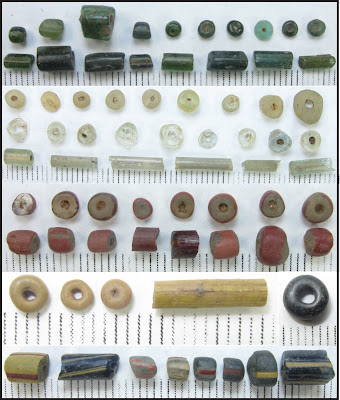By Artemios Oikonomou, Associate Editor for Archaeological Glass
After a quite long silence during the summer, it is now a good opportunity to share with you some fantastic news regarding- what else? Glass.
Glass studies have been focused mainly οn the “traditional” regions with rich archaeological remains/history such as Europe, Egypt, the Syropalestinian coast and Mesopotamia. Glass investigated dates roughly from the Late Bronze Age to the Medieval period with emphasis on Roman and Late Antique glass, principally because of the abundance of the retrieved objects from these periods.

Some of the glass beads recovered from Ife-Ife (Photo courtesy of Dr Abidemi Babalola).
Lately and thankfully, scientific attention has been driven towards “remote” areas which have not been studied systematically. In this direction, the research of Dr Abidemi Babalola (Research Fellow at the University of Cambridge) and his colleagues has given new insights into glassmaking in the sub-Saharan regions and in particular in SW Nigeria at the site of Ile-Ife. According to very recent results of this research (see here and references therein), there is substantial archaeological evidence for sophisticated local glass technology at Ile-Ife, dated to the very beginning of the 2nd millennium AD. Amazingly, the evidence shows that Ile-Ife was not only involved in secondary glass working, but also- and maybe more importantly- in primary glass production.
Primary glass production, until now, was thought to have been taking place in very specific places, mainly in Egypt and the Levantine coast, where the majority of the Roman and Late Antique glass was manufactured and distributed across the borders of the Empire. Remarkably, the rich archaeological evidence excavated at the Ile-Ife site makes it the first known primary glass workshop in sub-Saharan Africa. In particular, several pits that most likely represent ruins of furnace installations, over 20,000 glass beads, 1,500 crucible fragments and several kilograms of glass waste including semi-fused glass (halfway vitrified glass) have been unearthed.
Surprisingly, the scientific investigation of glass from Ile-Ife using analytical techniques (mainly SEM-EDS) revealed a unique chemical composition, clearly discernible when set against the known glass compositions. Specifically, substantial amounts of both alumina and lime led to the introduction of another glass category referred to as High Lime High Alumina (HLHA) glass. This is a unique result never noticed elsewhere up until now. These particular compositional features are related to the local geological components which suggest high experimentation/expertise of the local glassmakers to produce glass totally different from the already known glass groups (Levantine, HIMT, HMHK, Egypt I and II etc.). According to Dr Babalola, it is the use of uncommon raw materials, such as feldspar-rich granitic sand and/or pegmatite (silica source) along with snail shell that led to the reduction of the melting temperature of the silicate components.
The main product of the glass workshop (primary and secondary) at Ile-Ife was glass beads produced in vast quantities. These were considered to be luxurious items traded in West African towns and cities, such as Gao and Essouk (current Mali) and were also found in eastern Nigeria at Igbo Ukwu suggesting that Ile-Ife acted both as a supplier and a distributor of glass.
Overall, this exciting research gives new, fresh insights into sub-Saharan glassmaking placing the region among the key players of glassmaking during the beginning of the 2nd Millennium AD.
Stay tuned for more exciting glass news!!
Comments
Post a Comment